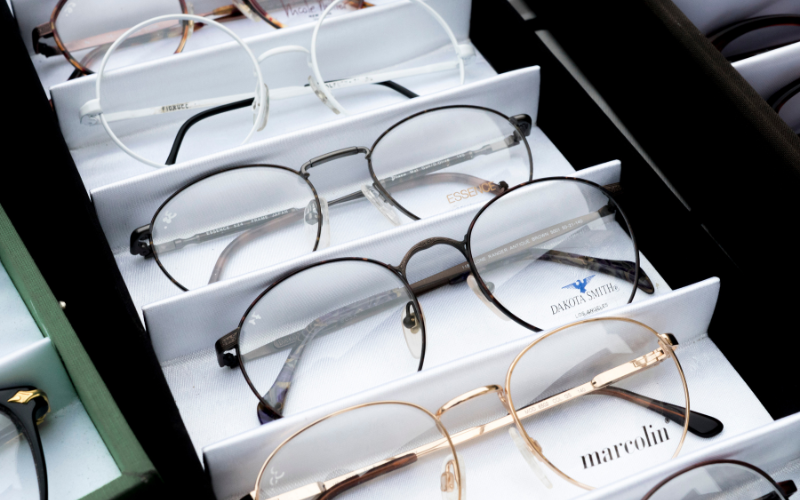Progressive Lenses vs. Other Eyeglass Lenses: Key Differences and Features
Progressive lenses have gained immense popularity for their seamless multi-distance vision capabilities, but how do they compare to other lens types such as single vision, bifocals, trifocals, or specialised lenses like photochromic or polycarbonate? Additionally, modern lenses offer advanced features like blue light filters and anti-glare coatings, which cater to specific needs. This guide explores how progressive lenses differ from other lens types and highlights the best additional features for different users.
Progressive Lenses: A Multifocal Marvel
Progressive lenses are designed for individuals with presbyopia, offering a smooth transition between near, intermediate, and distance vision zones without visible lines. Unlike bifocals or trifocals, they provide a seamless viewing experience, allowing wearers to switch focus naturally between different distances. This makes progressive lenses ideal for people who perform various tasks every day.
How Do Progressive Lenses Compare to Other Lens Types?
Single Vision Lenses
Single-vision lenses are tailored for a specific prescription, either for distance or near vision. They are simpler in design and are suited for people with general nearsightedness, farsightedness, or astigmatism. Unlike progressive lenses, single-vision lenses do not accommodate multi-distance vision needs, making them less versatile for users requiring near and far vision correction.
Bifocal Lenses
Bifocals contain two distinct zones—one for near vision and another for distance vision—separated by a visible line. While they effectively serve two purposes, the abrupt transition between zones can cause discomfort for some users. Progressive lenses solve this issue by offering a gradual shift between vision zones.
Trifocal Lenses
Trifocal lenses include three zones: near, intermediate, and distance. Like bifocals, they have visible lines that separate these zones. Progressive lenses offer a more aesthetically pleasing and comfortable alternative, eliminating the segmented appearance while providing similar functionality.
High-Index Lenses
High-index lenses are thinner and lighter than standard lenses, making them a great choice for people with strong prescriptions. They are compatible with progressive designs and provide a sleek, modern look, especially with features like anti-glare coatings.
Polycarbonate Lenses
Polycarbonate lenses are impact-resistant and lightweight, ideal for active individuals or children. While they may not directly compete with progressive lenses, they can be used in progressive designs for added durability.
Photochromic Lenses
Photochromic lenses adjust to changing light conditions, darkening outdoors and becoming clear indoors. Progressive photochromic lenses are excellent for individuals who spend significant time moving between indoor and outdoor environments, combining convenience with vision correction.
Polarised Lenses
Polarised lenses reduce glare and enhance visual clarity, especially in bright sunlight. They are commonly used in sunglasses and can be combined with progressive designs for individuals who require multifocal vision outdoors.
Anti-Reflective Lenses
Anti-reflective coatings minimise glare caused by screens and overhead lighting. Adding this feature to progressive lenses can improve clarity and comfort, especially for office workers and frequent computer users.
Prism Lenses
Prism lenses are designed to correct eye alignment issues, such as double vision. While not directly related to progressive lenses, they can be incorporated into a multifocal design if the wearer has specific vision alignment needs.
Choosing Additional Features for Progressive Lenses
To enhance the functionality of progressive lenses, several additional features can be included:
- Blue Light Filter: Ideal for people who spend long hours in front of digital screens, this feature reduces digital eye strain and improves comfort during extended screen time. It is particularly popular in Singapore’s tech-driven lifestyle.
- Anti-Glare Coating: Reduces reflections from screens, headlights, and other light sources, making it indispensable for drivers and office workers.
- UV Protection: Shields eyes from harmful UV rays, which is crucial for individuals who spend a lot of time outdoors.
- Scratch-Resistant Coating: Adds durability to lenses, making them suitable for active individuals or those who frequently handle their glasses.
- Water-Repellent Coating: Prevents water spots and smudges, ensuring clear vision in humid or rainy conditions—a practical choice in Singapore’s tropical climate.
Weighing the Costs Against Benefits
When choosing progressive lenses, consider how much value you place on customisation and added convenience. While basic progressive lense may suffice for everyday use, additional features can dramatically improve your visual experience, particularly if your lifestyle involves specific demands such as extensive screen time or outdoor activities. The progressive lens price in Singapore ensures options for varying budgets, enabling users to strike a balance between affordability and functionality.
Finding the Right Lens Combination
Progressive lenses stand out for their ability to accommodate multi-distance vision needs seamlessly, but understanding how they differ from other lens types is key to making the right choice. By adding features like blue light filters, anti-glare coatings, or UV protection, you can customise your lenses to suit your lifestyle. Whether you’re an office worker, an outdoor enthusiast, or juggling various tasks, the right combination of lenses and features ensures comfort, functionality, and style.
Finding your perfect lens match has never been easier. Contact Owndays today to learn more.
Stay in touch to get more news & updates on Bzz Discover!






